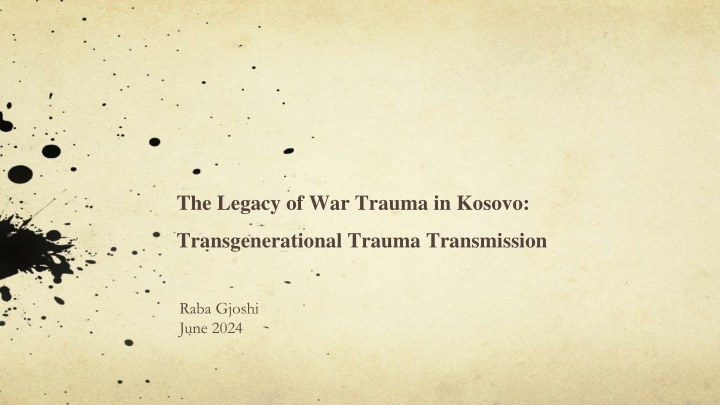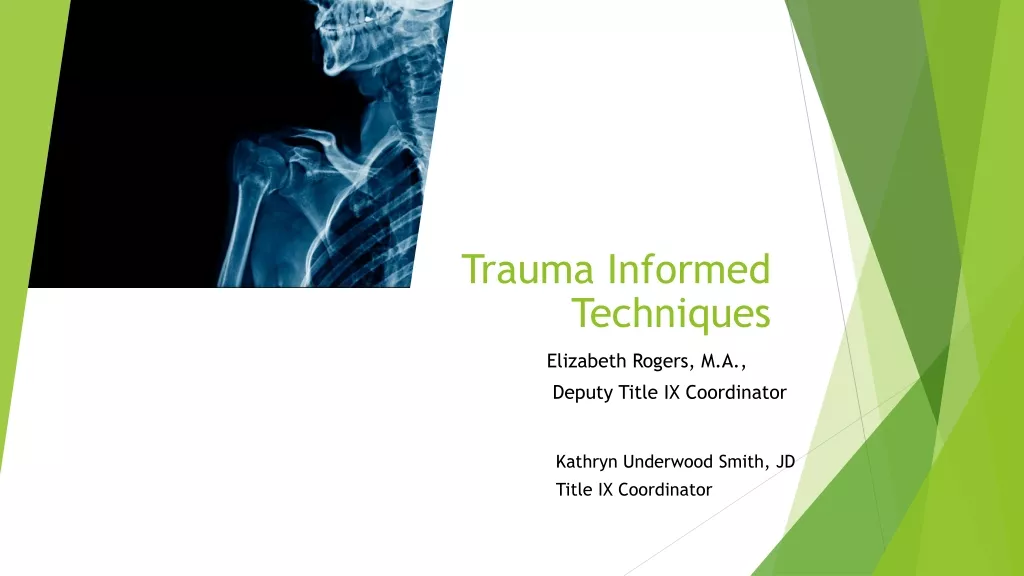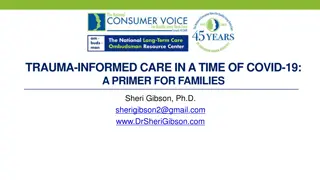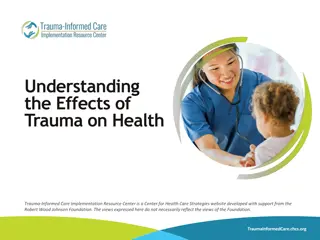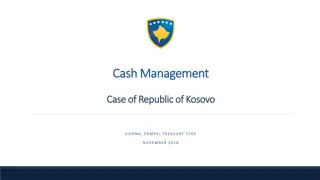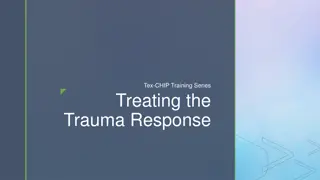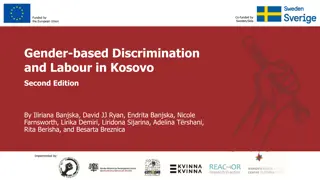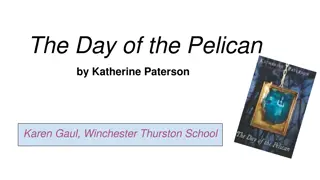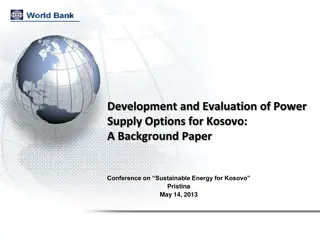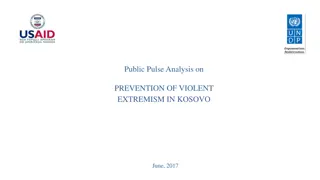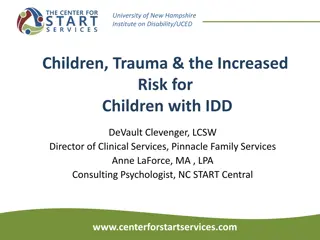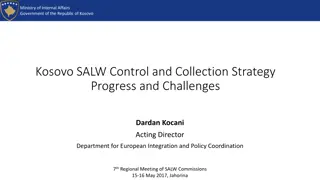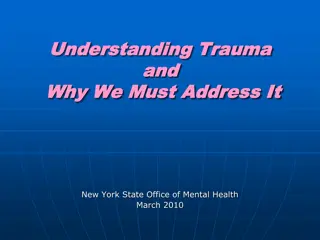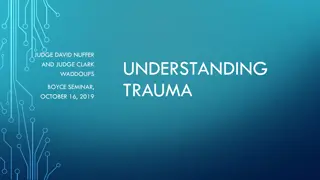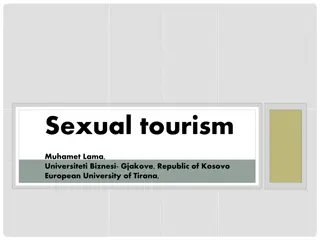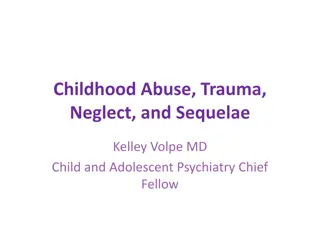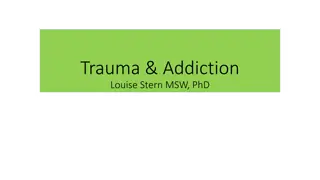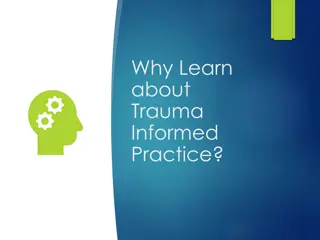Transgenerational Trauma Transmission in Kosovo: A Study on War Legacy
Investigating transgenerational trauma transmission among ethnic Albanian offspring of Kosovo war victims born between 1996-2001. The research explores the prevalence of traumatic events experienced by parents, participants' relationship to victims, and the Danieli Inventory's role in understanding multigenerational trauma legacies.
Download Presentation

Please find below an Image/Link to download the presentation.
The content on the website is provided AS IS for your information and personal use only. It may not be sold, licensed, or shared on other websites without obtaining consent from the author.If you encounter any issues during the download, it is possible that the publisher has removed the file from their server.
You are allowed to download the files provided on this website for personal or commercial use, subject to the condition that they are used lawfully. All files are the property of their respective owners.
The content on the website is provided AS IS for your information and personal use only. It may not be sold, licensed, or shared on other websites without obtaining consent from the author.
E N D
Presentation Transcript
The Legacy of War Trauma in Kosovo: Transgenerational Trauma Transmission Raba Gjoshi June 2024
Research Sample and Procedure Data collection: between May - August 2018 Research participants: N= 105 offspring of ethnic Albanian victims of the Kosovo war Born between 1996 and 2001 (up to two years before, during, and up to two years after the war Not exposed to a direct experience of war trauma themselves or have no conscious memory of any traumatic experiences.
Research Sample Participants relationship to the victims N 10 42 5 2 10 16 16 23 9 24 7 26 190 % 5 22 3 1 5 8 8 12 5 13 4 14 100 Mother Father Sister Brother Maternal grandmother Maternal grandfather Mother s sister (maternal aunt) Mother s brother (maternal uncle) Paternal grandmother Paternal grandfather Father s sister (paternal aunt) Father s brother (paternal uncle) Total Number of victims in participants families F 67 17 6 12 3 105 % 64 16 6 11 3 100 1 victim 2 victims 3 victims 4 - 9 family victims Undeclared Total
Research Sample Prevalence of Parents Traumatic Events Mother Father % 2 3 7 1 2 2 1 14 20 15 15 19 100 N 46 1 46 37 21 18 14 64 71 58 47 57 480 % 10 - 10 8 4 4 3 13 15 12 10 12 100 N Beating to the body Rape or sexual assault Torture Serious physical injury (from a bullet, grenade, knife, mines, fire) Imprisonment Kidnapping Forced labour in trenches, prisons, camps Forced separation from family members Forced expulsion from home Murder, or death due to violence, of other family member or friend Disappearance or kidnapping of other family member or friend Serious physical injury to family member or friend Total 9 10 27 2 6 7 4 52 75 56 58 72 378
Methodology & Theoretical Framework The Danieli Inventory of Multigenerational Legacies of Trauma The multidisciplinary, multidimensional integrative (TCMI) framework Parents posttrauma adaptational styles survivors coping style as well as the upbringing of their children in terms of emotional development, identity, and beliefs about themselves, society and the world The reparative impacts on survivors children the core, unconscious motivation to repair the past and heal their parents' trauma and themselves Generational linkage - connection between the offspring s identity and their grandparents and particularly the offspring s knowledge of their grandparents traumatic experiences Conspiracy of silence - indifference, avoidance and denial of traumatic experiences (crimes) to maintain the illusion of invulnerability Trauma mediators - patriarchal family, group superego, folklore, religion, and myths
Results The direct relationship between parents traumatic experiences and children s reparative adaptational impacts was not established. Separate analysis: mothers overall traumatic experiences significantly associated with children's reparative adaptational impacts, but fathers did not. In contrast with the findings of Schick et al. (2013), in which Kosovo Albanian children s depressive and PTSD symptoms were found in correlation with fathers symptoms of depression, anxiety and PTSD but not mothers . The present study not being focused on direct measurement of posttraumatic symptoms, such as anxiety and depression, but rather on the potential of children to develop or inherit psychological disorders. The difference between the effects of mothers and fathers trauma on children might have also been affected by the smaller number of participants with fathers who survived the war, particularly compared to those with mothers who survived.
Results Parents adaptational styles had a strong correlation with children s reparative adaptational impacts. Mothers adaptational styles had a stronger positive relationship than fathers adaptational styles. Mothers and fathers victim style had the strongest effect on children s reparative impacts. Mothers numb style had a stronger effect while fathers numb style a non-significant one. Both mothers and fathers fighter style had no effect. Parents victim style the clearest reflection of the trauma rupture, and, similar to the numb style conceived as a barrier to both parents and children s health, growth and protection from actual and imagined outside dangers (Danieli et al., 2015). The intensities of mothers and fathers victim styles were found to be the strongest predictors of the severity of children s reparative adaptational impacts and the level of increased vulnerability for developing psychological disorders (Danieli, Norris & Engdahl, 2017).
Results The impact of the conspiracy of silence on parents adaptational styles and children adaptational impacts was confirmed. Positive association with mothers and fathers numb style and a negative association with parents fighter style. Positive relationship with the children adaptational specific factors: Need for Power or Control and Obsession With the War - compatible with transgenerational trauma mediators patriarchal values, group superego, folklore, religion, and myths. High familial and societal conspiracy of silence in Kosovo i.e. victims of sexual violence, and victim families tendency to overprotect their children from their family victimhood stories. Familial conspiracy of silence: a way of parent(s) coping with the trauma, a barrier to both the parents and children s health, growth and protection from actual and imagined outside dangers, a resilience factor in intergenerational trauma transmission.
Results The intensity of generational linkage as an intermediary factor in transgenerational trauma transmission was found to be considerably high among most participants - a strong indication of the continuation of generational identity. The correlation of parents' adaptational styles with the generational identity item - a mediating factor, possibly unconscious, regardless of the Westernization and changing of the social value system which may appear superficially to have made young people less interested in traditions and weakened family ties. Negative correlation of fathers fighter style with the item on generational identity is in accordance with the patriarchal tradition in Kosovo - the burden of preserving and cultivating the family identity weighs on the father figure. The association between knowledge of family history with the Reparative Protectiveness implies the increased possibility for trauma to translate into future psychopathologies.
Limitations: Young age of participants: may not have been culturally familiar with some concepts of the questionnaire the risk of a lack of full knowledge about family histories Recommendations: Replication of the study after a few years when the second generation of the last war in Kosovo reach a certain age. Including a control group with children of families that do not have war victims in their immediate family.
